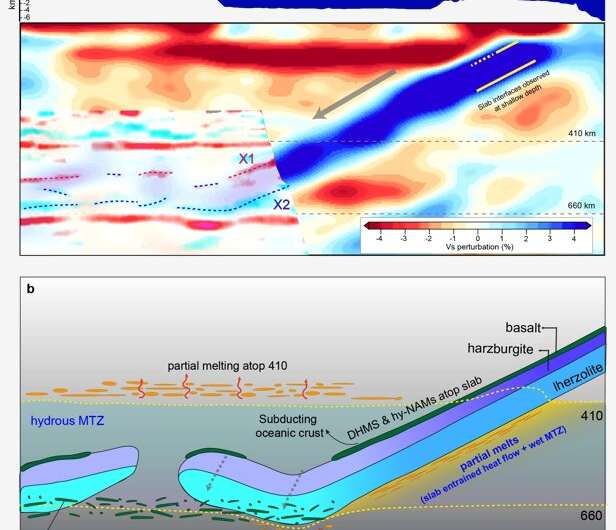Distinct slab interfaces found within mantle transition zone

The oceanic lithosphere descends into Earth's mantle as subducting slabs. Boundaries between the subducting slab and the surrounding mantle are defined as slab interfaces, whose seismic imaging is the key to understanding slab dynamics in the mantle. However, data on the existence of slab interfaces below 200 km remains elusive.
Prof. Chen Qifu's group from the Institute of Geology and Geophysics, Chinese Academy of Sciences (IGGCAS) and their collaborators observed two distinct seismic discontinuities within the mantle transition zone (~410 km to 660 km) beneath the western Pacific.
The two discontinuities represented the upper and lower boundaries of the subducted Pacific high-velocity slab, corresponding to the slab Moho and the surface of partially molten sub-slab asthenosphere, respectively.
This work was published in Nature Geoscience on Nov. 9.
The subduction process transports chemically differentiated and hydrated rocks into Earth's mantle, driving the cycles of heat and material changes between Earth's surface and its deep interior.
At shallow depths (<200 km), a variety of seismic reflection studies of subduction zones have identified the upper and/or lower interfaces of subducting slabs, all of which are characterized by sharp seismic velocity discontinuities.
The slab interfaces can be seismologically detected at shallow depths. However, how deep the seismic velocity discontinuities at slab interfaces can extend remains unclear, mainly due to the lack of high-resolution imaging of slab interfaces at depths below 200 km.
To understand the existence and origin of deep slab interfaces, the researchers took advantages of the dense seismic arrays in northeast China to study the upper mantle structures in the region.
They found sharp-dipping, double seismic velocity discontinuities within the mantle transition zone (~410 km to 660 km) beneath the western Pacific that coincide spatially with the upper and lower bounds of the high-velocity slab.
"Based on detail seismological analyses, the upper discontinuity was interpreted to be the Moho discontinuity of the subducted slab," said Prof. Chen. "The lower discontinuity is likely caused by partial melting of sub-slab asthenosphere under hydrous conditions in the seaward portion of the slab."
The imaged distinct slab-mantle boundaries at depths between 410 and 660 km, deeper than previously observed, suggest a compositionally layered slab and high-water contents beneath the slab.
More information: Distinct slab interfaces imaged within the mantle transition zone, Nature Geoscience (2020). DOI: 10.1038/s41561-020-00653-5 , www.nature.com/articles/s41561-020-00653-5
Journal information: Nature Geoscience
Provided by Chinese Academy of Sciences




















